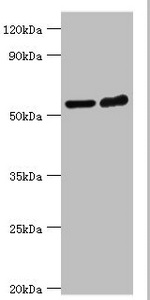Full Product Name
Rabbit anti-Homo sapiens (Human) MAPKAP1 Polyclonal antibody
Alternative Names
MAPKAP 1 antibody; MAPKAP1 antibody; MEKK2 interacting protein 1 antibody; MGC2745 antibody; MIP 1 antibody; MIP1 antibody; Mitogen activated protein kinase associated protein 1 antibody; Mitogen-activated protein kinase 2-associated protein 1 antibody; mSIN1 antibody; OTTHUMP00000064207 antibody; Ras inhibitor MGC2745 antibody; SAPK interacting protein 1 antibody; SAPK-interacting protein 1 antibody; SIN 1 antibody; SIN1_HUMAN antibody; SIN1b antibody; SIN1g antibody; Stress activated map kinase interacting protein 1 antibody; Stress activated protein kinase interacting 1 antibody; Stress-activated map kinase-interacting protein 1 antibody; Target of rapamycin complex 2 subunit MAPKAP1 antibody; TORC2 subunit MAPKAP1 antibody
Immunogen
Recombinant Human Target of rapamycin complex 2 subunit MAPKAP1 protein (1-290AA)
Immunogen Species
Homo sapiens (Human)
Purification Method
Antigen Affinity Purified
Concentration
It differs from different batches. Please contact us to confirm it.
Buffer
PBS with 0.02% sodium azide, 50% glycerol, pH7.3.
Tested Applications
ELISA, WB
Recommended Dilution
| Application |
Recommended Dilution |
| WB |
1:500-1:2000 |
Storage
Upon receipt, store at -20°C or -80°C. Avoid repeated freeze.
Lead Time
Basically, we can dispatch the products out in 1-3 working days after receiving your orders. Delivery time maybe differs from different purchasing way or location, please kindly consult your local distributors for specific delivery time.
Usage
For Research Use Only. Not for use in diagnostic or therapeutic procedures.




